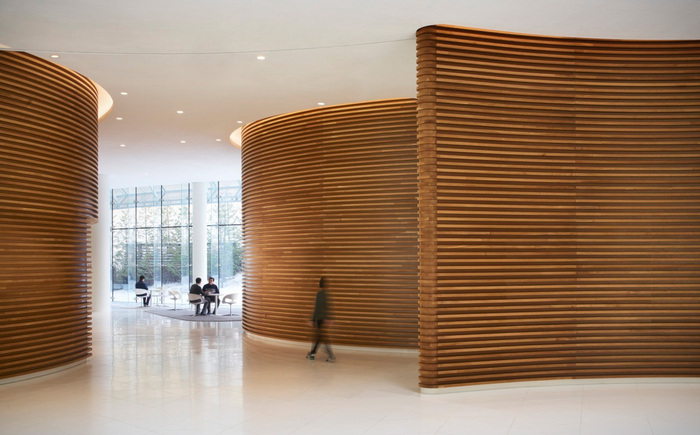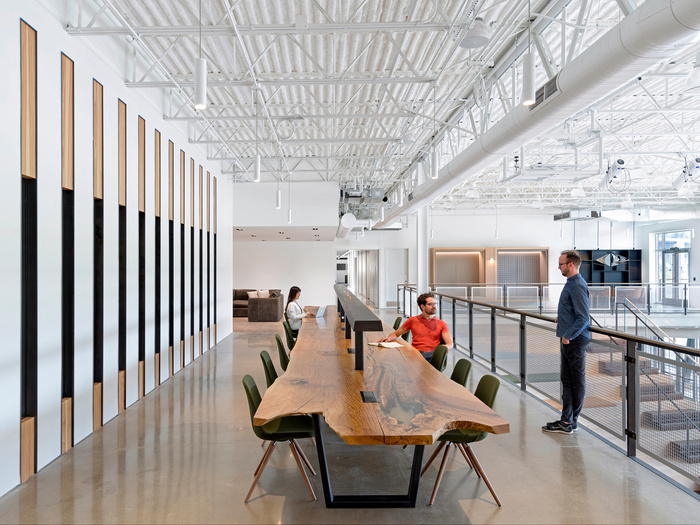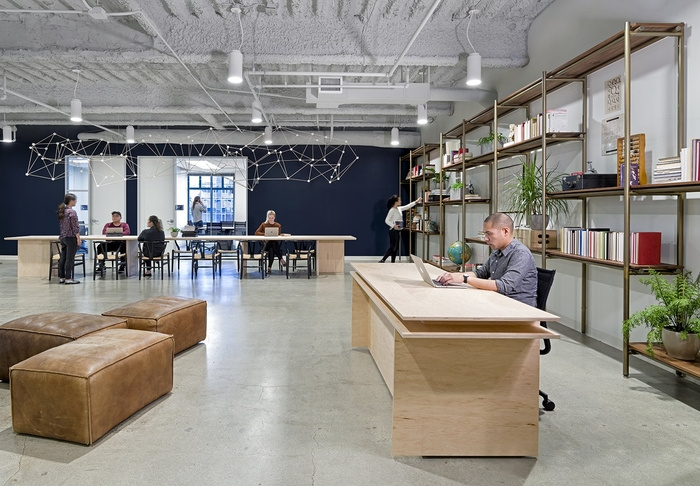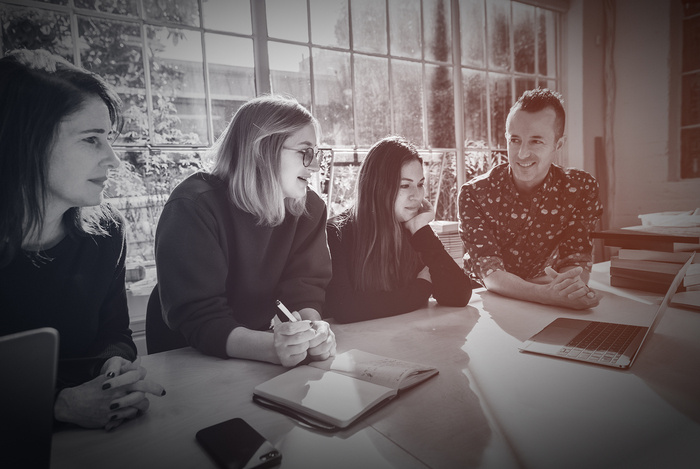
The Intro: Getting to Know CannonDesign
Founded in 1945, CannonDesign is no stranger to architecture and design. In a move to expand their workplace design capabilities, the firm recently joined with Assembly Design Studio at the end of 2017.
You may be familiar with CannonDesign as the name behind the offices of companies such as Comcast Spotlight, Echo Global Logistics, and The Martin Group. Assembly Design Studio’s portfolio includes projects for Uber, Pinterest and Quid.
CannonDesign’s newly expanded workplace design team is led by Meg Osman, Liz Guerrero, Denise Cherry, and Michael Bonomo (pictured above, left to right).
Excited about the news, we caught up with them to learn more about the practice and get their opinions on what impact the future may have on office design.
What originally made you want to get into the field of workplace interiors and office design?
Meg Osman: I began working in commercial real estate shortly after college and had the chance to work at organizations that touched each step in the design process during my career. Workplace interiors and office design excited me because of their ability to connect a client’s business objectives to the design process – essentially marrying my business background with design.
Liz Guerrero: I studied both graphic design and interior design in school. I still love both. But when I was a senior in college, I spent my final semester focused on my thesis, which turned out to be about workplace. Growing up both of my parents worked a lot, and I spent time around various work spaces and saw their impacts – both good and bad. I found it pretty fascinating how office environments can influence your life. I didn’t imagine I would still be focused on workplace today, but the work we do moves so fast and blurs so many boundaries that I never get bored. It keeps it interesting.
Michael Bonomo: At age five, I gravitated toward the verticality and magnetic nature of big cities. I’ve been sketching them since. For me, I’ve always known I wanted to be part of design that impacted urban life. As I headed in to college, I realized the tactile aspect of interiors on a very human level was where I could thrive. The workplace allows for design opportunities not present in more niche sectors in our industry.
Above: Hallway inside CJ Blossom Park's Suwon Offices (view project)
What types of project or clients do you enjoy working with most and why?
MB: We love working with disruptors, companies and individual looking to stand out, behave differently, be smarter, faster and never yield to the status quo. Whether that’s a tech company or another titan of industry, the key is being willing to push boundaries to inspire and attract great talent, clients and partners.
MO: We find projects that move past the status quo are usually the most complex, challenging and satisfying for designers. It’s working with clients that are willing to take educated and data-supported risks that really fuels our collective passion.
What has changed in the field since you each began your careers?
MO: Everything. Design has become such an important part of every company’s narrative – it’s really an exciting time. That fact we can utilize data to prove-out our design solutions gives us credibility and takes pressure off the C-Suite. They no longer have to make what people used to consider “subjective” design decisions, as they can now point to research and evidence to support decision-making.
MB: Everything Meg says is true. We’ve gone from designing on CRT monitors, using AutoCad and running blue line prints to designing with VR goggles, 3D printers and tablets. Change is energizing.
Above: Open work table at Uber ATG in Pittsburgh (view project)
How do you imagine the workplace changing and evolving in the next 20 years?
LG: I think it will evolve a great deal. Right now, technology is changing the way we work but it can still be a hindrance. I think in the next twenty years, technology will be more integrated and more so seamlessly integrated into the background. we’ll see more seamless technology design solutions in work environments. Already, we’re working with clients looking to make bold strides in this area.
MO: I hope in the next 20 years, organizations will rely less on trendy design ideas and focus more on what is right for them as their own unique organization – a highly customized solution that positively motivates their people and business. We’ve learned in recent years, “keeping up with the jones’” can be a dangerous proposition.
Is it helpful to think about the future when designing an office in the present? What might this look like for a client of CannonDesign?
LG: Absolutely. How people work is constantly changing and it can be challenging to try and predict where a company is going to be in two or five years, especially here in the Bay Area since there is so much rapid growth. People talk about “future proofing” designs, but I think what we can do is design for flexibility and always think about the people first.
MB: Definitely. Many of our clients are executing long-term leases or own their real estate. Given the length of commitment for most organizations, you need to ensure their environment can thrive amidst change. One project I recently worked on for a global engineering company employed multiple ways to reset each workstation, empowering individuals to adjust their space day-to-day and the organization to adapt as its culture changed over time. Design solutions need to be future focused or they’ll be obsolete on day one.
Can you each describe one office design mistake you wish people didn’t make?
LG: One is being constrained by your brand. The most successful office spaces encompass not only a company’s brand, but to also focus on the culture. They’re functional and supportive of the work; but they should inspire and make you happy.
MB: Believing the design is done at move in – it is not. Improvement and continual investment is part of offering a successful workplace.
MO: Using furniture as a correction device for lack of planning. Furniture should have strategic merit and not just be included to fill voids.
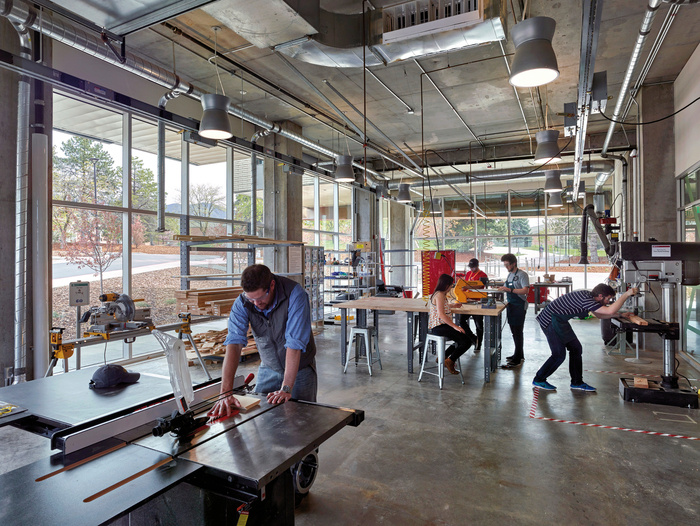 ©
© Above: University of Utah, Lassonde Studios by CannonDesign
Who are your favorite furniture or lighting designers right now?
Group: There are so many, some that jump to mind include Great Things to People, OneLux Studio, Ladies and Gentlemen Studio, PSLab, David Weeks lighting designs, Apparatus, Lambert & Fils, Lindsay Adelman, Fort Standard, Note Design Studio, Philipe Malouin, Simon James… the list goes on. There are so many people and teams doing exciting work in this arena.
If you could attend only one design show, which would you choose?
LG: Probably Salone. Orgatec and ICFF are great, too, for different reasons. Salone just has so much. It’s a bit of a sensory overload, but it’s impressive. If you’re ever going to go, be sure to balance it with plenty of time going to the pop-ups in Milan.
MO: Definitely SXSW in Austin. It brings together such a diverse range of topics and people. It’s on my To Do list in the next couple years.
And lastly, can you each describe your ideal work environment and where we would most likely find you when you’re not working?
MB: My ideal environment for work or relaxing is my terrace in DUMBO – it’s my favorite urban escape. If you close your eyes, the din of the traffic down on the Manhattan and Brooklyn Bridges ALMOST sounds like the churn of the ocean. If I’m chewing on a work idea, I’m usually sitting at my little Saarinen table outside in the sun. If I’m chewing on a filet I grilled, I’m likely at the same table but add a glass of wine.
LG: I’m pretty collaborative, so I like to sit in an open environment the majority of my time. Just a large table with my team, tons of natural light and plenty of pin-up space. When I need to focus, I like to get away from the office and work from a coffee shop. Working in a communal environment, keeps me more focused than hiding away. When I’m not working, my husband and I love to get out of the city and head to up to the wine country – that area of Northern California is just so beautiful. There’s so much to explore, and so many wineries are opening that are focused on people and community, making wine feel more accessible to a younger generation.
MO: I love variety in my work environment on a daily basis. Simply sitting in one position all day is not motivating for me. I tend to prefer soft seating areas with my feet up and laptop in my lap for concentrated work and open teaming tables for problem solving with a group. And, when I’m not working, you’ll likely find me in the kitchen cooking. It’s my decompression sport.
Above: Open office space inside Quid's San Francisco Offices (view project)
What projects are you currently working on?
MO: There’s so much going on. We’re currently working with a number of technology, financial services, retail and health companies. In New York and San Francisco, we’re building our teams out further to support a wider range of clients. We’ve also recently completed great work with companies like Uber, Vinfolio, Echo Global Logistics, The Martin Group to name a few. We’re lucky to work in an industry that never stands still.
Thank you!
You can connect with CannonDesign on their website, on Facebook, Twitter, Instagram, LinkedIn, and browse their projects on Office Snapshots.
